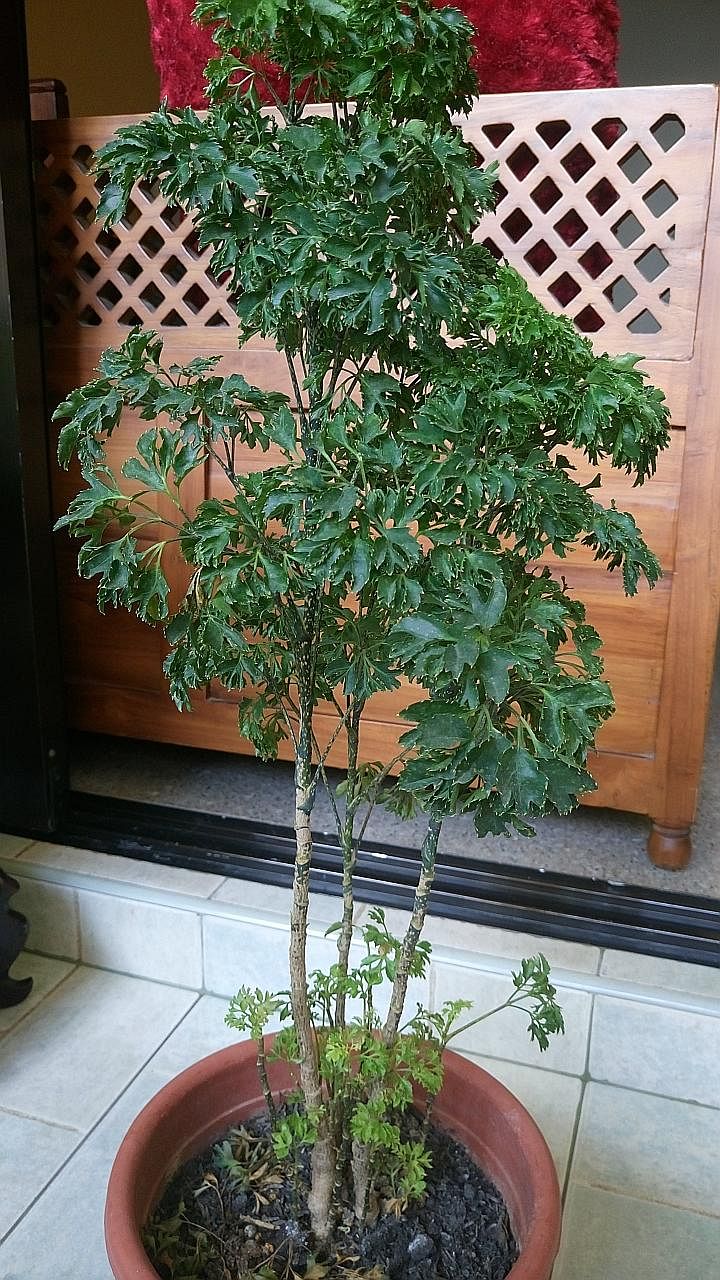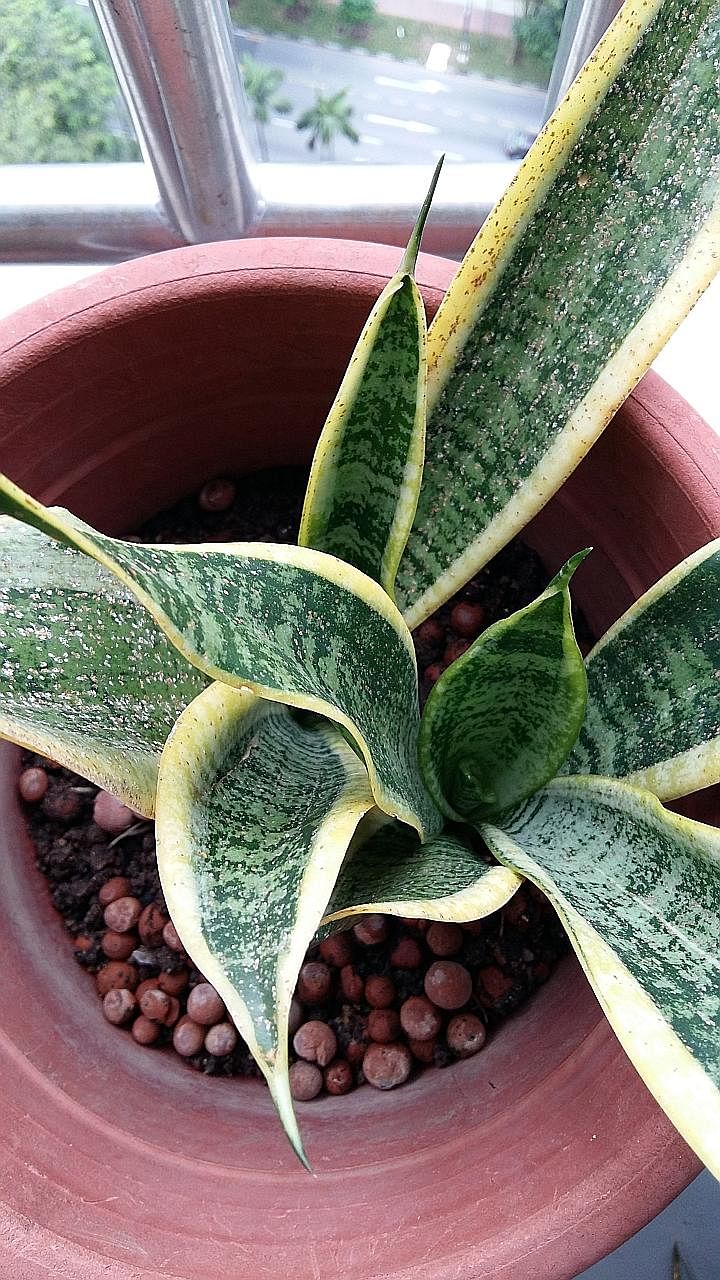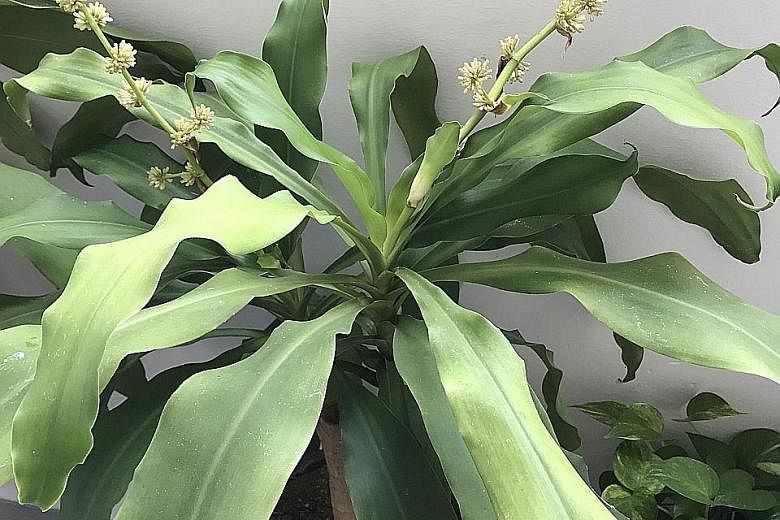Cold spell may have triggered rare blooms
I bought this plant about 12 years ago and it bloomed recently. Is this the "Iron" plant and is it true the plant rarely blooms?
Nicole Tan
This plant is commonly called the "Metal Tree" in Singapore. Its botanical name is Dracaena fragrans.
It is not observed to bloom freely here, so its flowering is often associated with the arrival of good fortune.
A drop in temperature is reported in some sources to trigger flowering in this plant.
The synchronised flowering that was observed recently could have been caused by the cold spell that occurred earlier this year in Singapore.

Ming Aralia may need more water or light
This plant has been with me for nearly a year. Lately, even though it is growing new shoots at the base, its leaves keep falling off. The foliage is also not firm as it used to be. What can I do?
Wai Ching Oh
This plant is commonly known as Ming Aralia. Its botanical name is Polyscias fruticosa. As it grows, lower leaves tend to fall away, leaving a bare stem.
Some gardeners cut down the plant to encourage the growth of new shoots and leaves, leading to a bushier plant.
But an excessive dropping of lower leaves could happen due to two reasons.
The first could be a lack of water. Ensure your plant is watered regularly to keep the root zone moist at all times. The drying out of the root zone can cause lower leaves to turn yellow and fall off.
The second reason could be a lack of light. If you are growing the plant in an apartment, it should be placed in a location where it can get at least four hours of direct sunlight daily.
Ensure all parts of the plant are exposed to sunlight. Rotating the plant periodically as well as elevating it, away from the shadow cast by the balcony or corridor parapet, may be necessary.
Note that foliage that does not receive light will die.
Trio of plants need better growing conditions
I have been growing these plants for quite some time, but they have started to look unhealthy. How do I care for them?
Bridget Kwek
The plants are the Bird's Nest Anthurium (Anthurium hybrid, photo 1), Chinese Evergreen (Aglaonema cultivar, photo 2) and Dumbcane (Dieffenbachia parlatorei, photo 3).

Your plants appear to have poor and lanky growth. They are probably pest-and disease-ridden. These issues could be due to a lack of sufficient light that is needed by the plants to grow well.
It is a misnomer to regard these plants as "indoor plants" that do not require sunlight to grow well. They are shade-tolerant plants, but still require some sunlight to thrive.
If you are living in an apartment, place these plants in a location such as the balcony or corridor, where they should be exposed to at least four hours of direct sunlight a day.
Ensure all parts of the plants are exposed to sunlight by rotating them periodically as well as moving them away from the shadow cast by the balcony or corridor parapet.
If you are displaying the plants at home, it may be a good idea to rotate them between being in the apartment and on the brighter balcony or along the corridor. This way, plants can recuperate in a sunny area after a week or fortnight in the apartment.
White flies possible root of cottony clusters
I found white cottony clusters on the underside of the leaves of my morning glory. They are also on the leaves and flowers of my Jatropha integerrima and hibiscus plants. Ants often crawl on the parts where these clusters are. Are they eggs laid by ants?
Sheena Goh
Your plant appears to be infested by white flies. The white patches are a non-mobile life stage of the pest.
To find out if it is a white fly infestation, you will see tiny, white flying insects when the leaves are disturbed.
As the picture is not clear, the pests might also be mealy bugs - these appear as cotton masses and do not fly when the leaves are moved.
The most environment-friendly method to manage such an infestation is to use a diluted soap solution or organic pesticides such as summer oil and neem oil.
Diluted solutions made from these can be sprayed on the white patches to dissolve the protective wax and kill the pestsunderneath. Repeated applications are often required for efficacy.
Also, note that these methods often reduce, but not eliminate the pests. The usage of chemical pesticides may be required for a more lasting effect, but should be employed only as a last resort.

Scale insects infesting Mother-in-law's Tongue
My Mother-in-law's Tongue has brown spots on its leaves. The condition seems to have spread to another pot of the same plant which has not had this problem before. What can I do to save the plants and prevent this from happening again?
Fiona Lau
Your Mother-in-law's Tongue has been infested by scale insects.
You can first use a soft toothbrush to remove these sucking plant pests, then spray an organic pesticide solution made from summer oil or neem oil on the plant.
These oils may be harmful to the plant, so it is advisable to test the spray on a small area to see if there are any negative effects before using it on the whole plant.
Follow the instructions on the label on how to dilute the oils and whether repeated spraying is needed to control the insect population.
If the pests return, you may need to use chemical pesticides instead.
• Answers by Dr Wilson Wong, a certified practising horticulturist and founder of Green Culture Singapore (www.greenculturesg.com). He is also an NParks-certified park manager.
• Have a gardening query? E-mail it with clear, high-resolution pictures of at least 1MB, if any, and your full name to stlife@sph.com.sg


